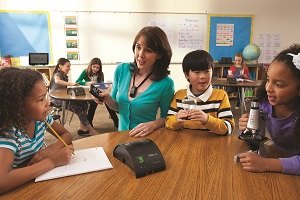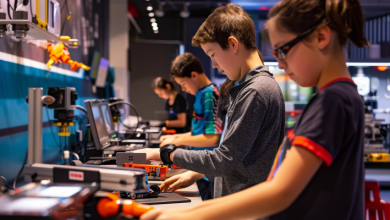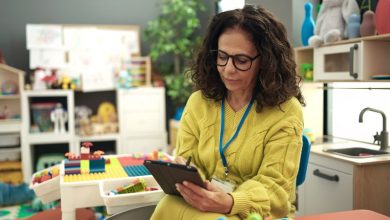Teaching for hearing-impaired learners

 Children gather 50-90 per cent of information through hearing alone so it is not surprising that the better they hear, the easier it is for them to learn.
Children gather 50-90 per cent of information through hearing alone so it is not surprising that the better they hear, the easier it is for them to learn.
Unfortunately, a typical classroom in session has a noise level of around 60 decibels, meaning a teacher’s voice needs to be at 75 decibels. This is essentially the same as having to give a lesson on a noisy street corner – not an easy task.
Consider too that children’s brains are not fully developed for listening until they are in their early teens, and primary-age children find it much harder to hear and understand their teacher.
Today’s teaching methods, such as group work and incidental learning, contribute to increasing noise levels in the classroom. Open-plan learning also presents new challenges for students, regardless of their hearing ability.
Research shows that to recognise speech, young children need a quieter setting than adults. Basic literacy and numeracy will not develop properly in an environment where they miss hearing key words, phrases and concepts.
According to The National Foundation for the Deaf Inc. (NFD), the key is in the classroom design. School planners and architects must begin the development process with good acoustics in mind.
Catering to children with hearing loss or learning difficulties provides a greater challenge as international research has shown that children with even mild hearing loss have 12 times the risk of educational failure than their normal hearing peers.
It is clear, therefore, that teachers need to make special considerations for hearing-impaired learners. These include facing the child when speaking, keeping distance between teacher and student to a minimum and using plenty of visuals to reinforce auditory information.
There are also a number of technologies available to support clear communication in the classroom. Phil Mellar from Sitech Systems NZ Ltd reports that the sound field systems – Lightspeed Soundfield and Lightspeed RedCat, in which sound is distributed evenly across the classroom using a wireless microphone and speakers, are proving very popular.
“Whenever we put the system into classrooms to trial, whether or not the school goes ahead and buys it, the teachers always want to keep it,” Mr Mellar says.
“The main thing is that the system does not add noise, it adds intelligibility. The teacher can be heard clearly throughout the classroom, without yelling.”
Improved audio can also reduce a child’s sensitivity to distraction, one of the most common impediments to listening. When sound and clarity is amplified, the teacher can better capture the student’s attention and the student does not have to expend as much energy blocking out distracting sounds or movement such as the hum of an air-conditioner or classmates moving around. This is especially important for children with learning difficulties such as Attention Deficit Disorder (ADD) and sensory processing disorders, who have much lower resilience to distraction than their neurologically typical (NT) classmates.
Ngongotaha Primary School principal, Cathryn Naera, says the Lightspeed Soundfield system has proven extremely beneficial to both staff and students.
“The clarity of the sound is excellent. Children are able to hear the voice of the teacher in all parts of the classroom. It has also been very beneficial for children when presenting their speeches or when reading to the class.”
Teacher wellbeing is improved, too. Research validated from the Mainstream Amplification Resource Room Study (MARRS Project) concludes that teacher absenteeism owing to voice problems can be reduced by half with the use of classroom audio. Teachers report that classroom management is enhanced and discipline problems are diminished because they have better voice control of every student in the classroom.
Systems start at around $1500-$2000 for a wireless microphone and speaker, and can be extended according to the classroom environment. A bigger room such as an innovative learning space (ILS) may require multiple microphones for the room’s teachers and speakers for different zones of the room. It can also be enhanced by a pod system, which allows a teacher and children out of normal earshot to speak to each other at the touch of a button, and enables the teacher to listen to the children even when they are out of sight. for example, in a breakout room.
Other audio technology available to help learners is the personal FM system. There are two types; the first is for children who wear hearing aids and is a device that transmits sound to a child through a receiver attached to a hearing aid. The second is designed for students with Auditory Processing Disorder (APD); the teacher wears a transmitter microphone and the child wears discreet miniature hearing aids that incorporate radio receivers so that the voice of the speaker is amplified and transmitted directly into the ears.
The Ministry of Education funds FM systems for some school-age children, accessible through the ministry’s special education department or through referral from audiology clinics.
It is important to understand that APD is not hearing loss and cannot be detected through a normal hearing test. Children with APD cannot process what they hear in the same way others do because their ears and brain don’t fully co-ordinate. Something interferes with the way the brain recognises and interprets sounds, especially speech.
A child with APD, thought to affect four per cent of school-age children in New Zealand, will typically exhibit difficulty understanding spoken language unless it is brief, clear and simple. They are likely to have trouble with comprehension, language, phonics, spelling and reading, and may also exhibit excessive tiredness after school from the strain of listening.
However, with the right therapy, children with APD can be successful in school and life. Early diagnosis is important because when the condition isn’t caught and treated early, a child can have speech and language delays or problems learning in school.
Interventions for APD include working with a speech and language therapist, and auditory training programmes. Using the TOMATIS® method, for example, the child wears a headset to listen to specific classical music and the human voice as a means to re-train and re-activate neural pathways. Over time, new connections are established between the ear, brain and body, gradually improving the child’s ability to process audio information. Access to the TOMATIS® method and other auditory integration therapies are available through private practitioners.








